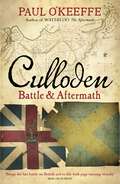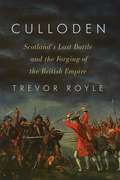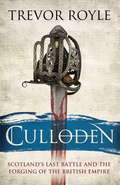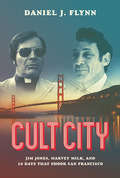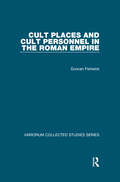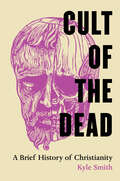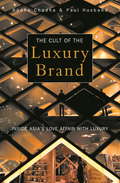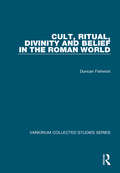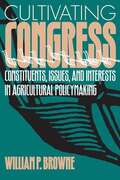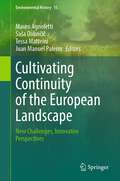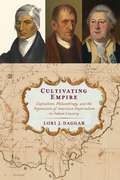- Table View
- List View
Culinary Technology of the Ancient Near East: From the Neolithic to the Early Roman Period
by Jill L. BakerCulinary Technology of the Ancient Near East discusses the technical aspects of meal preparation, cooking, and baking in the ancient Near East, exploring a wide range of topics including kitchens, cooking equipment, cooking and baking vessels, and serving and eating utensils. Chapters explore and describe the culinary technologies and techniques employed by the peoples of the ancient Near East from the Neolithic to the Early Roman period, considering their unique and pioneering contributions to the development and evolution of gastronomic devices and apparatus and highlighting some of the foods prepared by them, recognizing their application and influence in contemporary cooking and baking. Baker brings together in a single volume what is known about the culinary technology of the ancient Near East based on the archaeological, textual, historic, and scientific data drawn from a wide range of studies and discusses this data in terms of its cultural, historic, and socio-economic context. She emphasizes these technologies as the foundation upon which modern culinary technology is based and applies relevant ancient techniques to modern systems. Overall, the volume acknowledges the ingenuity of the ancient mind in order to understand their culinary technology, which in turn helps us better understand our own and apply these, and new, ideas to the present and future. This is a fascinating study suitable for students and scholars working on food and households in the ancient Near East, as well as those working on the history of food, cooking and dining, and the history of technology more broadly.
Culinary Texts in Context, 1500–1800: Manuscript Recipe Books in Early Modern Europe (Food Culture, Food History before 1900)
by Sarah Peters Kernan Helga MüllneritschThis collection represents a new and significant contribution to the study of recipe books from the early modern period (ca. 1500–1800) by situating them in a broader European context, traversing Catalonia, Finland, French and German-speaking regions, Ireland, Portugal, Spain, Sweden, and England. Ten essays, including a critical introduction to the genre, trace the materiality of the books and the use of the instructions therein, investigating patterns of recipe collection and their evolution over time; the international transmission of recipes, ingredients, and artisanal knowledge; and women’s manuscript culture. The authors explore how localised traditions of book production and domestic record-keeping shaped the physical forms of the books, and how stains, folds, marginalia, items pressed between pages, and pasted-in additions reveal their many uses. The inclusion of new ingredients and the integration of foreign recipes point to the many ways in which people, food, ideas, and books travelled the globe.
Culling the Masses: The Democratic Origins of Racist Immigration Policy in the Americas
by David Scott Fitzgerald David Cook-MartínCulling the Masses questions the widely held view that in the long run democracy and racism cannot coexist. David Scott FitzGerald and David Cook-Martín show that democracies were the first countries in the Americas to select immigrants by race, and undemocratic states the first to outlaw discrimination. Through analysis of legal records from twenty-two countries between 1790 and 2010, the authors present a history of the rise and fall of racial selection in the Western Hemisphere. The United States led the way in using legal means to exclude "inferior" ethnic groups. Starting in 1790, Congress began passing nationality and immigration laws that prevented Africans and Asians from becoming citizens, on the grounds that they were inherently incapable of self-government. Similar policies were soon adopted by the self-governing colonies and dominions of the British Empire, eventually spreading across Latin America as well. Undemocratic regimes in Chile, Uruguay, Paraguay, and Cuba reversed their discriminatory laws in the 1930s and 1940s, decades ahead of the United States and Canada. The conventional claim that racism and democracy are antithetical--because democracy depends on ideals of equality and fairness, which are incompatible with the notion of racial inferiority--cannot explain why liberal democracies were leaders in promoting racist policies and laggards in eliminating them. Ultimately, the authors argue, the changed racial geopolitics of World War II and the Cold War was necessary to convince North American countries to reform their immigration and citizenship laws.
Culloden Tales: Stories from Scotland's Most Famous Battlefield
by Hugh G. AllisonCulloden was the last battle on British soil. It marked the end of clan culture and was the harbinger of the Highland Clearances. It ensured the inevitability of the American Revolution and increased the outpouring of Scots across the globe. It is the only battle that British Army regiments are not permitted to include in their battle honours; the only battle that Bonnie Prince Charlie ever lost; and the only battle that the Duke of Cumberland ever won.Culloden is a battlefield, a graveyard and an iconic site that draws people from all parts of the world. And as they come, they bring with them their stories and their father's father's stories. These stories tell of civil war, of love, of the unexpected and even of the supernatural. They are peopled by the second-sighted, by clan chiefs and by others who have kept family secrets for centuries.The battlefield is a poignant location, resonant with past deeds and emotive memories. These Culloden tales are offered as a unique record to the power of the place.
Culloden, 1746: Battlefield Guide: Third Edition (Battleground Scotland Ser.)
by Stuart ReidA journey to the Highland battlefield where this landmark event in Scottish history took place, with numerous maps and illustrations. Culloden Moor is one of the most famous battles in British history and, for the Scots, the battle is pre-eminent, surpassing even Bannockburn. In this decisive and bloody encounter in 1746, the Duke of Cumberland&’s government army defeated the Jacobite rebels led by Prince Charles Edward Stuart. Yet, despite the attention paid to this critical event—in particular to Bonnie Prince Charlie and the Jacobite legend—few writers have concentrated on the battle itself and on the Highland battlefield on which it was fought. Stuart Reid, in this revised third edition of his bestselling guide, does just that. He tells the story of the campaign and sets out in a graphic and easily understood way the movements and deployments of the opposing forces, and he describes in vivid detail the deadly combat that followed. Incorporating the latest documentary and archaeological research and featuring a completely new and expanded section on the armies, it also invites visitors to explore for themselves this historic ground on which the tragic battle was fought.
Culloden: Battle & Aftermath
by Paul O'Keeffe'Excellent... It is a tremendous tale - one of the most dramatic in our island's history - and O'Keeffe tells it beautifully' The TimesCharles Edward Stuart's campaign to seize the British throne ended with one of the quickest defeats in history: on 16 April 1746, at Culloden, his Jacobite army was overpowered in under forty minutes. Its brutal repercussions, however, endured for years, its legacy for centuries.Paul O'Keeffe follows the Jacobite army from initial victories to calamitous defeat. Exploring the battle's aftermath, he chronicles the Jacobite prisoners paying for their treason on block and gibbet while those granted 'the King's mercy' suffered the fate of forced labour on plantations in the colonies. While Stuart's cause eventually acquired an aura of romanticism, the Jacobite Rising remains one of the most bloody and divisive conflicts in British domestic history, which resonates to this day.'Detailed, vivid - and not for the faint-hearted' Financial Times'Fascinating, meticulously researched... tremendous' Daily Mail'Intensely readable... and vividly written' Neal Ascherson, London Review of Books
Culloden: Scotland's Last Battle and the Forging of the British Empire
by Trevor RoyleA vigorous and authoritative history of last major battle fought between Scottish and English forces, ending all hope of the Stuarts reclaiming the throne and forming the bedrock for the creation of the British Empire. The Battle of Culloden in 1746 has gone down in history as the last major battle fought on British soil: a vicious confrontation between the English Royal Army and the Scottish forces supporting the Stuart claim to the throne. But this wasn't just a conflict between the Scots and the English: the battle was also part of a much larger campaign to protect the British Isles from the growing threat of a French invasion. In Trevor Royle's vivid and evocative narrative, we are drawn into the ranks, on both sides, alongside doomed Jacobites fighting fellow Scots dressed in the red coats of the Duke of Cumberland's Royal Army. And we meet the Duke himself, a skilled warrior who would gain notoriety because of the reprisals on Highland clans in the battle's aftermath. Royle also takes us beyond the battle as the men of the Royal Army, galvanized by its success at Culloden, expand dramatically and start to fight campaigns overseas in America and India in order to secure British interests. We see the revolutionary use of fighting techniques first implemented at Culloden, and we see the creation of professional fighting forces. Culloden changed the course of British history by ending all hope of the Stuarts reclaiming the throne, cementing Hanoverian rule and forming the bedrock for the creation of the British Empire. Royle's lively and provocative history looks afresh at the period and unveils its true significance, not only as the end of a struggle for the throne but the beginning of a new global power.
Culloden: Scotland's Last Battle and the Forging of the British Empire
by Trevor RoyleThe Battle of Culloden has gone down in history as the last major battle fought on British soil: a vicious confrontation between Scottish forces supporting the Stuart claim to the throne and the English Royal Army. But this wasn't just a conflict between the Scots and the English, the battle was also part of a much larger campaign to protect the British Isles from the growing threat of a French invasion. In Trevor Royle's vivid and evocative narrative, we are drawn into the ranks, on both sides, alongside doomed Jacobites fighting fellow Scots dressed in the red coats of the Duke of Cumberland's Royal Army. And we meet the Duke himself, a skilled warrior who would gain notoriety due to the reprisals on Highland clans in the battle's aftermath. Royle also takes us beyond the battle as the men of the Royal Army, galvanized by its success at Culloden, expand dramatically and start to fight campaigns overseas in America and India in order to secure British interests; we see the revolutionary use of fighting techniques first implemented at Culloden; and the creation of professional fighting forces. Culloden changed the course of British history by ending all hope of the Stuarts reclaiming the throne, cementing Hanoverian rule and forming the bedrock for the creation of the British Empire. Royle's lively and provocative history looks afresh at the period and unveils its true significance, not only as the end of a struggle for the throne but the beginning of a new global power.
Culloden: Scotland's Last Battle and the Forging of the British Empire
by Trevor RoyleThe Battle of Culloden has gone down in history as the last major battle fought on British soil: a vicious confrontation between Scottish forces supporting the Stuart claim to the throne and the English Royal Army. But this wasn't just a conflict between the Scots and the English, the battle was also part of a much larger campaign to protect the British Isles from the growing threat of a French invasion. In Trevor Royle's vivid and evocative narrative, we are drawn into the ranks, on both sides, alongside doomed Jacobites fighting fellow Scots dressed in the red coats of the Duke of Cumberland's Royal Army. And we meet the Duke himself, a skilled warrior who would gain notoriety due to the reprisals on Highland clans in the battle's aftermath. Royle also takes us beyond the battle as the men of the Royal Army, galvanized by its success at Culloden, expand dramatically and start to fight campaigns overseas in America and India in order to secure British interests; we see the revolutionary use of fighting techniques first implemented at Culloden; and the creation of professional fighting forces. Culloden changed the course of British history by ending all hope of the Stuarts reclaiming the throne, cementing Hanoverian rule and forming the bedrock for the creation of the British Empire. Royle's lively and provocative history looks afresh at the period and unveils its true significance, not only as the end of a struggle for the throne but the beginning of a new global power.
Culloden: The History and Archaeology of the Last Clan Battle
by Tony PollardA team of historians and archaeologists re-examine what happened at the Battle of Culloden between the Scottish Jacobites and Great Britain. In battle at Culloden Moor on April 16, 1746, the Jacobite cause was dealt a mortal blow. The power of the Highland clans was broken. And the image of sword-wielding Highlanders charging into a hail of lead delivered by the red-coated battalions of the Hanoverian army has passed into legend. The battle was a turning point in British history. And yet our perception of this critical episode tends to be confused by mistaken, sometimes partisan, views of the events on the battlefield. So, what really happened at Culloden? In this fascinating and original book, a team of leading historians and archaeologists reconsiders every aspect of the battle. They examine the latest historical and archaeological evidence, question every assumption, and rewrite the story of the campaign in vivid detail. This is the first time that such a distinguished team of experts has focused on a single British battle. The result is a seminal study of the subject, and it is a landmark publication of battlefield archaeology.Praise for Culloden&“Culloden is one of the best documented British battles and also one of the most mapped, yet the contributions to this fine volume have succeeded in finding new material.&” —Scotts Magazine (UK)
Culloden: The History and Archaeology of the Last Clan Battle
by Tony PollardA team of historians and archaeologists re-examine what happened at the Battle of Culloden between the Scottish Jacobites and Great Britain. In battle at Culloden Moor on April 16, 1746, the Jacobite cause was dealt a mortal blow. The power of the Highland clans was broken. And the image of sword-wielding Highlanders charging into a hail of lead delivered by the red-coated battalions of the Hanoverian army has passed into legend. The battle was a turning point in British history. And yet our perception of this critical episode tends to be confused by mistaken, sometimes partisan, views of the events on the battlefield. So, what really happened at Culloden? In this fascinating and original book, a team of leading historians and archaeologists reconsiders every aspect of the battle. They examine the latest historical and archaeological evidence, question every assumption, and rewrite the story of the campaign in vivid detail. This is the first time that such a distinguished team of experts has focused on a single British battle. The result is a seminal study of the subject, and it is a landmark publication of battlefield archaeology.Praise for Culloden&“Culloden is one of the best documented British battles and also one of the most mapped, yet the contributions to this fine volume have succeeded in finding new material.&” —Scotts Magazine (UK)
Cult Cinema: An Introduction (Routledge Media And Cultural Studies Companions Ser.)
by Ernest Mathijs Jamie SextonCult Cinema: an Introduction presents the first in-depth academic examination of all aspects of the field of cult cinema, including audiences, genres, and theoretical perspectives. Represents the first exhaustive introduction to cult cinema Offers a scholarly treatment of a hotly contested topic at the center of current academic debate Covers audience reactions, aesthetics, genres, theories of cult cinema, as well as historical insights into the topic
Cult City: Jim Jones, Harvey Milk, and 10 Days That Shook San Francisco
by Daniel J. FlynnIn recounting the fascinating, intersecting stories of Jim Jones and Harvey Milk, Cult City tells the story of a great city gone horribly wrong. November 1978. Reverend Jim Jones, the darling of the San Francisco political establishment, orchestrates the murders and suicides of 918 people at a remote jungle outpost in South America. Days later, Harvey Milk, one of America’s first openly gay elected officials—and one of Jim Jones’s most vocal supporters—is assassinated in San Francisco’s City Hall. This horrifying sequence of events shocked the world. Almost immediately, the lives and deaths of Jim Jones and Harvey Milk became shrouded in myth. Now, forty years later, this book corrects the record. The product of a decade of research, including extensive archival work and dozens of exclusive interviews, Cult City reveals just how confused our understanding has become. In life, Jim Jones enjoyed the support of prominent politicians and Hollywood stars even as he preached atheism and communism from the pulpit; in death, he transformed into a fringe figure, a “fundamentalist Christian” and a “fascist.” In life, Harvey Milk faked hate crimes, outed friends, and falsely claimed that the US Navy dishonorably discharged him over his homosexuality; in death, he is honored in an Oscar-winning movie, with a California state holiday, and a US Navy ship named after him. His assassin, a blue-collar Democrat who often voted with Milk in support of gay issues, is remembered as a right-winger and a homophobe. But the story extends far beyond Jones and Milk. Author Daniel J. Flynn vividly portrays the strange intersection of mainstream politics and murderous extremism in 1970s San Francisco—the hangover after the high of the Summer of Love.
Cult Filmmakers: 50 Movie Mavericks You Need to Know (Cult Figures)
by Ian Haydn SmithDiscover the iconic personalities behind cult classic films, from David Lynch and Roger Corman to Sofia Coppola, Gordon Parks, John Waters, and more.Whether pioneering in their craft, fiercely unique, or critically divisive, cult filmmakers come in all shapes and guises. Some gain instant fame or notoriety while many others remain anonymous until a cultural shift propels their work into the limelight. In Cult Filmmakers, Ian Haydn-Smith picks a selection of brilliant directors you should know—from industry heavyweights like Tim Burton and David Lynch, to brilliant but lesser-known auteurs such as Alejandro Jodorowsky and Ana Lily Amirpour. With biographical background and critical insight, you’ll discover the minds behind such beloved features as Melancholia, Easy Rider, Lost in Translation and more.Featuring:Ana Lily AmirpourDarren AronofskyJohn CarpenterPark Chan-WookDavid Cronenberg Terry GilliamDennis HopperJim JarmuschHarmony KorineRuss MeyerGaspar NoeQuentin TarantinoMelvin van PeeblesLars von Trier, John WatersAnd many others
Cult Musicians: 50 Progressive Performers You Need to Know (Cult Figures)
by Robert Dimery“Even the most avid music fan will make some new discoveries in these pages.” —The CurrentWhat makes a cult musician? Whether pioneering in their craft, fiercely and undeniably unique, or critically divisive, cult musicians come in all shapes and guises. Some gain instant fame, others instant notoriety, and more still remain anonymous, with small, devout followings, until a chance change in fashion sees their work propelled into the limelight.Cult Musicians introduces fifty beyond-the-mainstream musicians deserving of a cult status in genres from afrobeat and art pop to glam rock and proto punk. Weird and wonderful, innovators and boundary breakers, they include Alex Chilton and Aphex Twin, Bobbie Gentry and Brian Eno, Kat Bjelland and Kool Keith, Nick Drake and Nick Cave—and dozens more with a special ability to inspire, antagonize, and delight. Included are insightful profiles, discographies, and striking illustrations by Kristelle Rodeia.
Cult Places and Cult Personnel in the Roman Empire
by Duncan FishwickThe twenty-one studies assembled in this volume focus on the apparatus and practitioners of religions in the western Roman empire, the enclaves, temples, altars and monuments that served the cults of a wide range of divinities through the medium of priests and worshippers. Discussion focuses on the analysis or reconstruction of the centres at which devotees gathered and draws on the full range of available evidence. While literary authorities remain of primary concern, these are for the most part overshadowed by other categories of evidence, in particular archaeology, epigraphy, numismatics and iconography, sources in some cases confirmed by the latest geophysical techniques - electrical resistivity tomography or ground-probing radar. The material is conveniently presented by geographical area, using modern rather than Latin terminology: Rome, Italy, Britain, Gaul, Spain, Hungary, along with a broader section that covers the empire in general. The titles of the various articles speak for themselves but readers may find the preface of interest in so far as it sets out my ideas on the use of ancient evidence and the pitfalls of some of the approaches favoured by modern scholars. Together with the wide range of individual papers the preface makes the book of interest to all students of the Roman empire as well as those specifically concerned with the history of religions.
Cult of Glory: The Bold and Brutal History of the Texas Rangers
by Doug J. SwansonA twenty-first century reckoning with the legendary Texas Rangers that does justice to their heroic moments while also documenting atrocities, brutality, oppression, and corruptionThe Texas Rangers came to life in 1823, when Texas was still part of Mexico. Nearly 200 years later, the Rangers are still going--one of the most famous of all law enforcement agencies. In Cult of Glory, Doug J. Swanson has written a sweeping account of the Rangers that chronicles their epic, daring escapades while showing how the white and propertied power structures of Texas used them as enforcers, protectors and officially sanctioned killers.Cult of Glory begins with the Rangers' emergence as conquerors of the wild and violent Texas frontier. They fought the fierce Comanches, chased outlaws, and served in the U.S. Army during the Mexican War. As Texas developed, the Rangers were called upon to catch rustlers, tame oil boomtowns, and patrol the perilous Texas-Mexico border. In the 1930s they began their transformation into a professionally trained police force. Countless movies, television shows, and pulp novels have celebrated the Rangers as Wild West supermen. In many cases, they deserve their plaudits. But often the truth has been obliterated. Swanson demonstrates how the Rangers and their supporters have operated a propaganda machine that turned agency disasters and misdeeds into fables of triumph, transformed murderous rampages--including the killing of scores of Mexican civilians--into valorous feats, and elevated scoundrels to sainthood. Cult of Glory sets the record straight.Beginning with the Texas Indian wars, Cult of Glory embraces the great, majestic arc of Lone Star history. It tells of border battles, range disputes, gunslingers, massacres, slavery, political intrigue, race riots, labor strife, and the dangerous lure of celebrity. And it reveals how legends of the American West--the real and the false--are truly made.
Cult of the Dead: A Brief History of Christianity
by Kyle SmithA cultural history of how Christianity was born from its martyrs. Though it promises eternal life, Christianity was forged in death. Christianity is built upon the legacies of the apostles and martyrs who chose to die rather than renounce the name of their lord. In this innovative cultural history, Kyle Smith shows how a devotion to death has shaped Christianity for two thousand years. For centuries, Christians have cared for their saints, curating their deaths as examples of holiness. Martyrs’ stories, lurid legends of torture, have been told and retold, translated and rewritten. Martyrs’ bones are alive in the world, relics pulsing with wonder. Martyrs’ shrines are still visited by pilgrims, many in search of a miracle. Martyrs have even shaped the Christian conception of time, with each day of the year celebrating the death of a saint. From Roman antiquity to the present, by way of medieval England and the Protestant Reformation, Cult of the Dead tells the fascinating story of how the world’s most widespread religion is steeped in the memory of its martyrs.
Cult of the Luxury Brand
by Paul Husband Radha ChadhaWith Hong Kong boasting more Gucci and Hermäs stores than New York or Paris, and 94% of young women in Tokyo owners of a Louis Vuitton bag, the Asian consumer is a new target for brand-creation. TheCult of the Luxury Brand illuminates the mysterious inner workings of Asia's love affair with luxury for business professionals and intrigued consumers alike.
Cult, Ritual, Divinity and Belief in the Roman World (Variorum Collected Studies #994)
by Duncan FishwickThe papers assembled in this selection of studies range in subject matter from early Judaic magic to an inscribed monument of the Neo-Classical period. The principal emphasis of the collection is nevertheless on religious developments under the High Roman Empire: problems arising from the interpretation of oriental cults imported from the Hellenistic East but primarily the development of imperial cult, the one universal religion of the empire before the coming of Christianity. The essays divide into five categories: Divinity and Power; The Imperial Numen; The Imperial Cult: Review and Discussion; Rituals and Ceremonies; Ainigmata. The titles of the individual articles speak for themselves but readers may also find the preface of interest in so far as it sets out the author's ideas on the controversial nature of the emperor's divinity. While this is a topic deserving of a book in its own right, the preface together with the points raised by individual studies within the overall framework may go some way to repairing this defficiency.
Cultish: The Language of Fanaticism
by Amanda Montell“One of those life-changing reads that makes you see—or, in this case, hear—the whole world differently.” —Megan Angelo, author of Followers“At times chilling, often funny, and always perceptive and cogent, Cultish is a bracing reminder that the scariest thing about cults is that you don't realize you're in one till it's too late.”—Refinery29.comThe New York Times bestselling author of The Age of Magical Overthinking and Wordslut analyzes the social science of cult influence: how “cultish” groups, from Jonestown and Scientologists to SoulCycle and social media gurus, use language as the ultimate form of power.What makes “cults” so intriguing and frightening? What makes them powerful? The reason why so many of us binge Manson documentaries by the dozen and fall down rabbit holes researching suburban moms gone QAnon is because we’re looking for a satisfying explanation for what causes people to join—and more importantly, stay in—extreme groups. We secretly want to know: could it happen to me? Amanda Montell’s argument is that, on some level, it already has . . .Our culture tends to provide pretty flimsy answers to questions of cult influence, mostly having to do with vague talk of “brainwashing.” But the true answer has nothing to do with freaky mind-control wizardry or Kool-Aid. In Cultish, Montell argues that the key to manufacturing intense ideology, community, and us/them attitudes all comes down to language. In both positive ways and shadowy ones, cultish language is something we hear—and are influenced by—every single day. Through juicy storytelling and cutting original research, Montell exposes the verbal elements that make a wide spectrum of communities “cultish,” revealing how they affect followers of groups as notorious as Heaven’s Gate, but also how they pervade our modern start-ups, Peloton leaderboards, and Instagram feeds. Incisive and darkly funny, this enrapturing take on the curious social science of power and belief will make you hear the fanatical language of “cultish” everywhere.
Cultivating Community: Women and Agricultural Fairs in Ontario (McGill-Queen's Rural, Wildland, and Resource Studies)
by Jodey NurseFor close to two hundred years, families and individuals across Ontario have travelled down country roads and gathered to enjoy seasonal agricultural fairs. Though some features of township and county fairs have endured for generations, these community events have also undergone significant transformations since 1850, especially in terms of women’s participation.Cultivating Community tells the story of how women’s involvement became critical to agricultural fairs’ growth and prosperity. By examining women’s diverse roles as agricultural society members, fair exhibitors, performers, volunteers, and fairgoers, Jodey Nurse shows that women used fairs’ manifold nature to present different versions of rural womanhood. Although traditional domestic skills and handicrafts, such as baking, needlework, and flower arrangement, remained the domain of women throughout this period, women steadily enlarged their sphere of influence on the fairgrounds. By the mid-twentieth century they had staked out a place in venues previously closed to them, including the livestock show ring, the athletic field, and the boardroom.Through a wealth of fascinating stories and colourful detail, Cultivating Communities adds a new dimension to the social and cultural history of rural women, placing their activities at the centre of the agricultural fair.
Cultivating Congress: Constituents, Issues, and Interests in Agricultural Policymaking
by William P. BrowneCongress in the mid-1990s remains the object of voter discontent. Public outcries against special interests and unresponsive incumbents have amplified an already pervasive skepticism toward Beltway politics. And while Congress continues to conduct its business, William Browne argues that it is no longer business as usual. Browne opens up the inner sanctums of Congress to reveal how that institution's daily operations-i. e. , its policymaking processes-have changed dramatically. He argues that Congress is no longer dominated by party and committee power-brokers, large organized interest groups, or intrusive federal agencies. Instead, he contends, congressional members are driven largely by grassroots issues and constituent interests. This shift occurred in response to reforms that diluted the congressional seniority system and empowered the rank-and-file to exert greater influence in policymaking. More members now generate more issues much earlier in that process, resulting in a greater diversity of views in previously entrenched policy domains, but also greater disorganization and less predictability. Those changes are nowhere more apparent than in the ever shifting arena of agricultural policymaking, which, as the single largest contributor to our GNP, remains a central part of American politics. As agriculture has become more fragmented, globalized, and environmentally aware, agricultural policymaking has grown increasingly complex. In the process, a cacophony of constituent policy demands has altered the way congressional members "play the game. " Browne reveals exactly how that new game is played. Based on nearly 450 interviews with members of Congress, their staff, agency administrators, and lobbyists, Browne's study is timed to appear during the 1995 Congressional debates over a major new agriculture bill. His book should become a major resource--for congressional staff, journalists, political scientists, economists, lobbyists, and policy administrators--for understanding those debates.
Cultivating Continuity of the European Landscape: New Challenges, Innovative Perspectives (Environmental History #15)
by Mauro Agnoletti Saša Dobričič Tessa Matteini Juan Manuel PalermThis edited volume reviews 20 years’ worth of research under the European Landscape Convention. The authors from the research network UNISCAPE offer readers insights into their combined efforts to carry out and support the goals of a sustainable European landscape. 20 years after defining these original goals, the editors make landscape ecology and management, a cornerstone for the debate on a 21st century Europe. The numerous contributions cover the three major areas of Landscape Policy and Governance, Landscape Design and Time and Observing Landscape. The pan-European approach highlights the strength of international collaboration and interdisciplinary thinking.This book offers the collected knowledge as a working tool for researchers, scholars and professionals in landscape ecology.
Cultivating Empire: Capitalism, Philanthropy, and the Negotiation of American Imperialism in Indian Country (Early American Studies)
by Lori J. DaggarCultivating Empire charts the connections between missionary work, capitalism, and Native politics to understand the making of the American empire in the late-eighteenth and early-nineteenth centuries. It presents American empire-building as a negotiated phenomenon that was built upon the foundations of earlier Atlantic empires, and it shows how U.S. territorial and economic development went hand-in-hand. Lori. J. Daggar explores how Native authority and diplomatic protocols encouraged the fledgling U.S. federal government to partner with missionaries in the realm of Indian affairs, and she charts how that partnership borrowed and deviated from earlier imperial-missionary partnerships.Employing the terminology of speculative philanthropy to underscore the ways in which a desire to do good often coexisted with a desire to make profit, Cultivating Empire links eighteenth- and early-nineteenth-century U.S. Indian policy—often framed as benevolent by its crafters—with the emergence of racial capitalism in the United States. In the process, Daggar argues that Native peoples wielded ideas of philanthropy and civilization for their own purposes and that Indian Country played a critical role in the construction of the U.S. imperial state and its economy. Rather than understand civilizing missions simply as tools for assimilation, then, Cultivating Empire reveals that missions were hinges for U.S. economic and political development that could both devastate Indigenous communities and offer Native peoples additional means to negotiate for power and endure.





